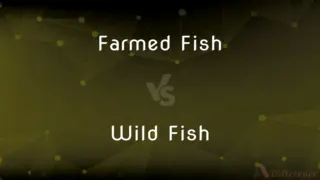Sloth vs. Snail — What's the Difference?
Edited by Tayyaba Rehman — By Urooj Arif — Updated on April 17, 2024
Sloths are slow-moving mammals known for their arboreal lifestyle in tropical rainforests, while snails are terrestrial or aquatic mollusks, recognized for their even slower pace and distinctive shells.

Difference Between Sloth and Snail
Table of Contents
ADVERTISEMENT
Key Differences
Sloths are mammals found primarily in the tropical rainforests of Central and South America, adapted to an arboreal lifestyle, spending most of their lives hanging from trees. On the other hand, snails can be found worldwide in various environments, including gardens, forests, and bodies of water, equipped with a hard shell for protection against predators and environmental conditions.
Sloths are noted for their extremely slow metabolism, which aligns with their low-energy diet of leaves and occasional fruits. Whereas snails, depending on the species, can consume a wide range of foods from decomposing vegetation to animal matter, with their dietary flexibility helping them survive in diverse habitats.
The movement speed of sloths is famously slow, averaging around 0.24 kilometers per hour, which is an evolutionary trait to conserve energy. On the other hand, snails are even slower, with some species moving as little as 0.013 kilometers per hour, using their muscular foot to glide over surfaces with the aid of mucus.
Sloths have a unique fur ecosystem; algae grow on their coarse fur, which helps camouflage them in the trees. In contrast, snails have a hard, often spiral shell that they retreat into when threatened, providing physical protection.
Sloths tend to be solitary creatures except during mating season, and they give birth to one offspring at a time. Meanwhile, many snail species can reproduce, often laying eggs that hatch multiple young, which contributes to their ability to populate diverse environments quickly.
ADVERTISEMENT
Comparison Chart
Habitat
Tropical rainforests
Diverse environments (land and water)
Diet
Primarily leaves and fruits
Varied; includes vegetation and animal matter
Speed
Extremely slow (0.24 km/h)
Even slower (up to 0.013 km/h)
Body Protection
Algae-covered fur for camouflage
Hard shell for physical protection
Reproduction
Solitary; one offspring per birth
Can be solitary or communal; multiple eggs
Compare with Definitions
Sloth
Solitary creatures except during mating.
Outside of mating season, sloths prefer to be alone.
Snail
Can inhabit both terrestrial and aquatic environments.
While some snails live in gardens, others are found in freshwater habitats.
Sloth
Known for their extremely slow movements.
The sloth moves so slowly that algae grows on its fur.
Snail
Mollusks with a coiled shell for protection.
The snail retreats into its shell at the first sign of danger.
Sloth
Dependent on the forest ecosystem for survival.
Deforestation threatens the sloth's natural habitat.
Snail
Capable of reproduction.
Some snail species can reproduce without a mate, laying eggs that will develop into new snails.
Sloth
Mammals adapted to life in the treetops of rainforests.
Sloths spend most of their time in trees, rarely coming to the ground.
Snail
Diet can include vegetation and sometimes animal matter.
Garden snails help decompose dead plant material.
Sloth
Have a low-energy diet consisting mostly of leaves.
Due to their diet, sloths have a very slow metabolic rate.
Snail
Utilize a muscular foot to move and secrete mucus.
The trail left by a moving snail is due to the mucus it secretes.
Sloth
Any of several slow-moving arboreal mammals of South America and Central America; they hang from branches back downward and feed on leaves and fruits
Snail
A snail is, in loose terms, a shelled gastropod. The name is most often applied to land snails, terrestrial pulmonate gastropod molluscs.
Sloth
Sloths are a group of arboreal Neotropical xenarthran mammals, constituting the suborder Folivora. Noted for their slowness of movement, they spend most of their lives hanging upside down in the trees of the tropical rainforests of South America and Central America.
Snail
Any of numerous aquatic or terrestrial gastropod mollusks that typically have a spirally coiled shell, retractile foot, and distinct head.
Sloth
Reluctance to work or make an effort; laziness
He should overcome his natural sloth and complacency
Snail
A slow-moving, lazy, or sluggish person.
Sloth
A slow-moving tropical American mammal that hangs upside down from the branches of trees using its long limbs and hooked claws.
Snail
Any of very many animals (either hermaphroditic or nonhermaphroditic), of the class Gastropoda, having a coiled shell.
Sloth
A group of bears
The pair had been attacked by a sloth of bears
Snail
A slow person; a sluggard.
Sloth
Aversion to work or exertion; laziness; indolence.
Snail
(engineering) A spiral cam, or a flat piece of metal of spirally curved outline, used for giving motion to, or changing the position of, another part, as the hammer tail of a striking clock.
Sloth
A member of the genus Bradypus, having three long-clawed toes on each forefoot. Also called ai, three-toed sloth.
Snail
A tortoise or testudo; a movable roof or shed to protect besiegers.
Sloth
A member of the genus Choloepus, having two toes on each forefoot. Also called two-toed sloth, unau.
Snail
The pod of the snail clover.
Sloth
A group of bears.
Snail
(railroading) A locomotive with a prime mover but no traction motors, used to provide extra electrical power to another locomotive.
Sloth
(uncountable) Laziness; slowness in the mindset; disinclination to action or labour.
Snail
To move or travel very slowly.
Sloth
(countable) A herbivorous, arboreal South American mammal of the families Megalonychidae and Bradypodidae, noted for its slowness and inactivity.
Snail
Any one of numerous species of terrestrial air-breathing gastropods belonging to the genus Helix and many allied genera of the family Helicidæ. They are abundant in nearly all parts of the world except the arctic regions, and feed almost entirely on vegetation; a land snail.
Sloth
(rare) A collective term for a group of bears.
Snail
Hence, a drone; a slow-moving person or thing.
Sloth
To be idle; to idle (away time).
Snail
A spiral cam, or a flat piece of metal of spirally curved outline, used for giving motion to, or changing the position of, another part, as the hammer tail of a striking clock.
Sloth
Slowness; tardiness.
These cardinals trifle with me; I abhorThis dilatory sloth and tricks of Rome.
Snail
A tortoise; in ancient warfare, a movable roof or shed to protect besiegers; a testudo.
They had also all manner of gynes [engines] . . . that needful is [in] taking or sieging of castle or of city, as snails, that was naught else but hollow pavises and targets, under the which men, when they fought, were heled [protected], . . . as the snail is in his house; therefore they cleped them snails.
Sloth
Disinclination to action or labor; sluggishness; laziness; idleness.
[They] change their course to pleasure, ease, and sloth.
Sloth, like rust, consumes faster than labor wears.
Snail
The pod of the sanil clover.
Sloth
Any one of several species of arboreal edentates constituting the family Bradypodidæ, and the suborder Tardigrada. They have long exserted limbs and long prehensile claws. Both jaws are furnished with teeth (see Illust. of Edentata), and the ears and tail are rudimentary. They inhabit South and Central America and Mexico.
Snail
Freshwater or marine or terrestrial gastropod mollusk usually having an external enclosing spiral shell
Sloth
To be idle.
Snail
Edible terrestrial snail usually served in the shell with a sauce of melted butter and garlic
Sloth
A disinclination to work or exert yourself
Snail
Gather snails;
We went snailing in the summer
Common Curiosities
How do sloths and snails differ in their diets?
Sloths primarily eat leaves and fruits, conserving energy, whereas snails have more varied diets that can include both vegetation and animal matter.
What are the speeds of sloths and snails?
Sloths move very slowly at about 0.24 km/h, while snails are even slower, some moving at only 0.013 km/h.
What unique characteristics define sloths?
Sloths are known for their slow pace and unique adaptation to arboreal life.
Can you explain the reproductive differences between sloths and snails?
Sloths are mostly solitary and bear one offspring at a time, whereas snails can lay multiple eggs, some species reproducing.
How do the reproductive strategies of sloths and snails impact their populations?
Sloths have slower population growth due to their solitary nature and single offspring, while snails can quickly populate areas due to their ability to lay multiple eggs.
How do sloths and snails protect themselves?
Sloths use camouflage with algae-covered fur, while snails have a hard shell for physical protection.
What are the typical lifespans of sloths and snails?
Sloths can live up to 30 years or more, whereas the lifespan of snails varies widely, some living only a few years.
Where do sloths and snails typically live?
Sloths live in the rainforests of Central and South America, while snails are found in diverse environments worldwide.
What are the conservation statuses of sloths and snails?
Some sloth species are endangered due to habitat loss, while many snails are not, though specific species may also face threats.
How do sloths' and snails' habitats affect their survival?
Sloths depend on the forest canopy for survival, while snails adapt to both land and aquatic environments.
What environmental threats do sloths face?
Deforestation is a significant threat to sloths by destroying their natural habitat.
What are some unique features of snails?
Snails are recognized for their protective shells and slow movement using a muscular foot.
How do snails contribute to their ecosystems?
Snails help in decomposing vegetation, contributing to nutrient cycling in their environments.
How do human activities impact sloths and snails?
Human activities such as deforestation and pollution threaten sloths, while habitat destruction and pesticide use can affect snail populations.
How do sloths and snails adapt to their environments?
Sloths have adapted to conserve energy in nutrient-poor environments, while snails' shells protect them in various environments.
Share Your Discovery

Previous Comparison
Step vs. Stage
Next Comparison
Orchard vs. VineyardAuthor Spotlight
Written by
Urooj ArifUrooj is a skilled content writer at Ask Difference, known for her exceptional ability to simplify complex topics into engaging and informative content. With a passion for research and a flair for clear, concise writing, she consistently delivers articles that resonate with our diverse audience.
Edited by
Tayyaba RehmanTayyaba Rehman is a distinguished writer, currently serving as a primary contributor to askdifference.com. As a researcher in semantics and etymology, Tayyaba's passion for the complexity of languages and their distinctions has found a perfect home on the platform. Tayyaba delves into the intricacies of language, distinguishing between commonly confused words and phrases, thereby providing clarity for readers worldwide.












































